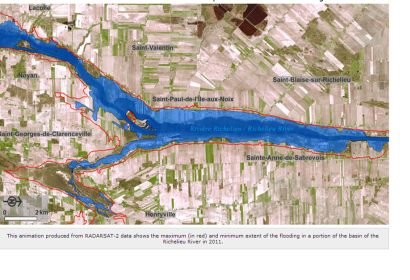Within the framework of the international Committee on Satellite Earth Observation (CEOS), the Canadian Space Agency (CSA) is collaborating with NASA on various projects helping to prevent, manage and respond to natural disasters. During the spring flood along the Richelieu River in May 2011, CSA asked colleagues from NASA to acquire satellite images with the EO-1/ALI sensor in order to capture the flood extent. The ALI images complement an entire time series of RADARSAT-2 images acquired by the Canadian Government over the affected region, providing additional details thanks to the multi-spectral and pan-chromatic imaging capabilities of ALI.
Through the new Rapid Information Products and Services (RIPS) initiative, the CSA’s Earth Observation Applications and Utilizations (EOAU) Division, in close cooperation with Public Safety Canada (PS) and Effigis, developed flood maps and geo-information products derived from the RADARSAT-2 and EO-1/ALI data. A time series animation of 16 RADARSAT-2 SAR images of the most severely flooded areas along the Richelieu River was also developed by the project team. This information serves geospatial information needs and requirements by federal as well as provincial stakeholder organizations, notably PS, the Sécurité Civile du Québec and Québec municipalities. The animation produced from RADARSAT-2 data showing the maximum and minimum extent of the flooding is accessible online.
Emergency Management is a core responsibility of the Government of Canada and a collective responsibility of all federal government institutions. This is why PS is taking steps to promote a coordinated approach and more uniform structure to the management of emergencies by providing guidance to federal government institutions on how to develop an emergency management plan.

